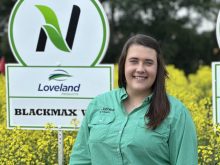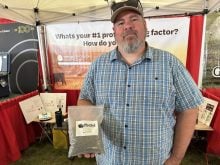We often hear “plant it down” when a field is not performing well for annual crops. That may mean simply planting some grass and accepting hay yields determined by the moisture in a given year.
It is not uncommon for such stands to perform poorly and then be utilized as pasture. There are many situations where a perennial grass stand is not treated as a crop by providing adequate nutrition. This piece will provide some facts about fertility and hay yields.
Bromegrass and nitrogen
The best source of information I was aware of was from the Scott, Sask., Federal Research Farm and the substations associated with Scott. Harry Ukrainetz had data for several sites over several years.

Figure 1 (above) shows two-year total hay yield with nitrogen alone, and with nitrogen (N) plus phosphorus (P). Scott soil is acid and low-P status. The P rate was 80 pounds of P2O5/acre, applied once. Often response of hay to P occurs only when yields are pushed with high N rates. Normal rainfall at Scott is about 11 inches annually.
Figure 2 (below) shows a better-watered site like Loon Lake where the yields are about double those at Scott. N doubled the yield.

John Harapiak of (then) Westco Fertilizers also did very long-term (30-year), continuous bromegrass fertilization experiments on a Black soil with 18 inches of annual rainfall. The site was at Carstairs Alta., about 30 miles north of Calgary.
Figure 3 (below) shows the 19-year average hay yield at the Black soil site at Carstairs, Alta. An annual 100 pounds N/acre application more than quadrupled the annual hay yield.

Not much doubt about it. What are often called sodbound tame grass hay fields are really just starving for nitrogen. Of course, when the nitrogen requirements are met, other nutrients may be required to provide the balance. In time, phosphorus will be a universal requirement; potassium will be required on sandy and other efficient soils. For low-organic matter Grey soils, sulphur will often also be required.
The long-term experiments with bromegrass also included single nitrogen rates as high as 1,000 pounds N /acre. Those high rates provided useful data for environmental concerns as well as agronomic. While very high rates did provide large responses for a few years, they come with risks.
N and grass
The most practical solution for grass hay fertilization is to apply about 100 pounds N/acre each year. The annual result will vary with the rainfall, but in the long term, that will average out. Of course, the fifth “R” of nitrogen management, balance, must always be considered.
Read Also

Claas brings 1000 Series SP forage harvesters to Canada
In mid-August, Claas unveiled its new line of Jaguar forage harvesters at an event in Visalia, California, deep in the heart of that state’s dairy region.
Much of the older work on this topic was done using ammonium nitrate (34-0-0) as the nitrogen source — the best N fertilizer ever! That is no longer available, but urea (46-0-0) and UAN solution (28-0-0) are the main choices. The results for those sources may sometimes be a bit less than the old standby, but they do the job.
Alfalfa
I am currently considering the feasibility of planting my little patch to alfalfa as a three+ year break from annual cropping. My rotation for years was wheat, peas, wheat, canola. That was too much wheat and fusarium head blight was the result. There are band-aids for that problem but there are no solutions. We might think that peas one year in four is OK, but I have recently seen examples where that is questionable. Aphanomyces is to peas as FHB is to wheat. Band-aids but no solutions.
My strategy for alfalfa will be to broadcast a high rate of 11-52-0 fertilizer before planting. Sulphur may come from a local source of gypsum and for my soil, I currently do not anticipate potassium fertilization.
The morning after
For any perennial hay crop, we must consider the fate of crops to follow. The first requirement is always water. Perennial hay crops, particularly alfalfa, do a good job of sucking the soil dry.
In a recent local example, a half-section of land that had been in permanent grass hay for several years came up for rent after the grass had been eliminated.
In today’s agriculture, one of the big advantages of a long break from annual cropping is to eliminate inoculum of troublesome disease or any troublesome weed problems. That was the big incentive to rent the grass breaking in the local example.
The big drawback in converting from grass to annual cropping is that most grass fields are almost devoid of available nitrogen unless they have been well fertilized. Regardless of fertilization, the soil will have almost no moisture.
My advice was to not plant an annual crop until the soil was recharged with water. In the late summer and fall of the grass-breaking year, rainfall was much above normal. Before freeze-up, I was able to easily explore the soil moisture to four feet or more. So, it was good to go. With good agronomic practices, the field has produced well for several years.
Alfalfa fixes its own nitrogen, and the nitrogen bill after alfalfa can be very low. My rule of thumb has been that after breaking a good alfalfa stand, very little fertilizer N is needed for the first crop. Some residual benefits can last up to three years and after that it is back to normal annual crop fertilization.
We must remember that alfalfa removes large quantities of phosphorus, potassium and sulphur. Annual crops seeded after alfalfa breaking must take those nutrients into account.
















